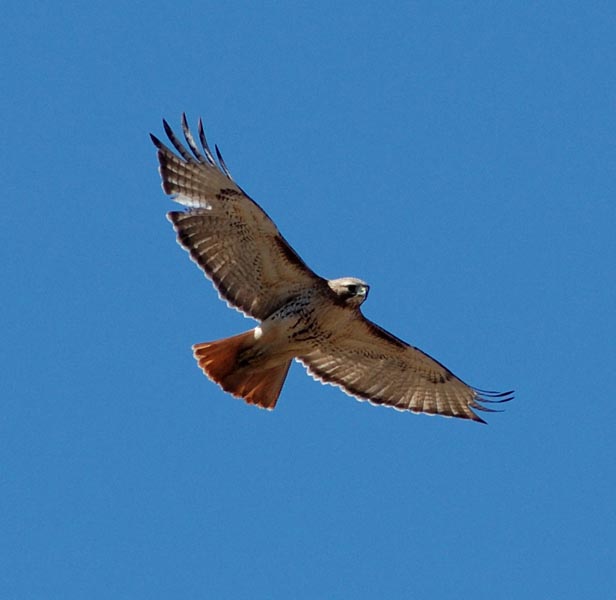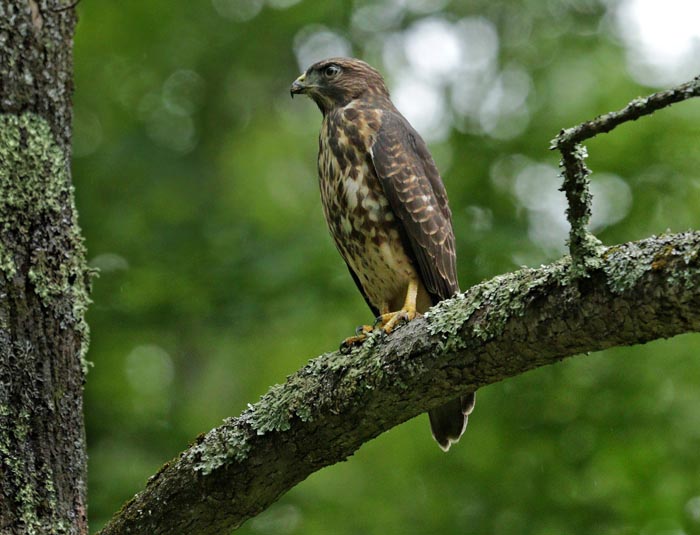Wherever you are in the Hudson Valley this winter, there is likely to be an array of hawks, falcons, eagles and owls perched on a tree, swooping in on their prey or blending in with the bark of the tree cavity in which they’re roosting.
One of the easiest hawks to spot in the region is the red-tailed hawk, with its solid white chest, its beautiful broad wings and of course, its trademark reddish-brown tail. They’re commonly seen posing on a roadside telephone pole or fencepost or at the top of a tree their silhouettes both bulky and majestic.
“Their wings are rounded and have a four-foot wingspan, which allows them to just hang on the wind and look for their prey,” said Steve Stanne of New Paltz, who worked for years as the education coordinator of the Hudson River Estuary Program for the Department of Environmental Conservation (DEC). “They’re easy to spot soaring above fields and meadows because their wings allow them to kite and float in the air. Their tail opens like a fan.”

Stanne said that a juvenile hawk’s tail is not red, but “brown with bars across it. They don’t turn red until they’re several years old.”
Also dwelling in our region are red-shouldered hawks – not as prevalent as the red-tailed – as well as sharp-shinned hawks and Cooper’s hawks, which are smaller and have shorter wings and “longer tails, which allow them to turn and swerve and dive and maneuver very quickly,” explained Stanne.
If you have a bird feeder, you might see some of these hawks visiting the backyard, as they like to feed on songbirds. “We know when a Cooper’s hawk is at our feeder, because we hear the birds crashing against the window trying to fly away!”
Hawks eat voles, rabbits, rats, ground squirrels, snakes and some birds as well. “It’s nature. It’s tough for them [hawks], too.”
For birders, telling the difference between hawk and a falcon is like being able to tell one sibling or offspring apart from another; but for your layperson, it’s not that simple. One of the easier ways to note the difference is that hawks are generally larger than falcon. Falcons also have long, tapered wings while hawks have wider wings with softer, rounded edges.
Other raptors that can be seen along the Shawangunk Ridge, as well as the foothills, meadows and riversides of the Wallkill and Hudson Valleys, include peregrine falcons, American kestrels, ospreys, broad-winged hawks, turkey vultures, bald eagles and various species of owls.

There are some owl species that you may not be able to see, but you can certainly hear, like the great horned owls. They nest in the area early in the season and can be found in woodland habitats. There is also the screech owl, which has a call similar to a horse whistle, and barred owls, which like to whoop it up. “There was one screech owl right on Huguenot Street that would roost in a hole in the tree.” There have been a few local sightings of the snowy owl, according to Stanne, but mostly they’re found in farmlands up north of Albany.
Since most owls are nocturnal, one has to rely on the sounds that they make, which can vary from rap to jazz to operatic notes. To familiarize yourself with the sounds of particular owls, you can spend lots of time in the woods – always a fun adventure – or get a crash course by going to the Cornell University ornithology website, where they have audio versions of each raptor you may be interested in learning about: www.birds.cornell.edu.
Both the peregrine falcon and the bald eagle have made comebacks through great efforts by environmental groups, land preservation organizations and the DEC. DDT and other dangerous pesticides, used for years in agriculture to kill mosquitoes and other bugs, do not break down, and thus poison the food chain from the mud-dwelling worms to the airborne eagles. They ended up leaving only one pair of bald eagles alive in the State of New York in the 1970s. “And that pair was sterile,” said Stanne. “That was in 1974, and in an effort to bring them back, New York brought in birds from other states and put them in artificial nests in likely habitats and fed them in a way that they wouldn’t recognize humans has a food source and hoped that they would return years later to nest – which is what they did.”
Now bald eagles can be seen along the Hudson River, the Wallkill River and the Ashokan Reservoir, to name a few spots. “They soar widely,” said Stanne, “and they like big bodies of water. In the winter, when the smaller rivers and lakes are frozen over, you’ll be much more likely to see them along the Hudson River – particularly in Peekskill and Haverstraw, where there’s open water.”

Peregrine falcons made their comeback to the Shawangunks after near-extinction. Still on the New York State Endangered Species List, Peregrine Falcons are carefully monitored by the Mohonk Preserve in concert with the DEC to “ensure the continued recovery of the species. For over 20 years, Mohonk Preserve has been monitoring and protecting peregrine falcons through the annual Peregrine Watch program. Each year, the peregrines are monitored by Conservation Programs staff and volunteers during the peregrine breeding season from late February through August. A volunteer orientation for this program will be held on February 17. For more information, visit www.mohonkpreserve.org/volunteer/training.” To protect the nesting raptors, the Preserve will often close down specific climbing and bouldering routes in the West Trapps. Once the chicks, called eyases, are born and fly the coop, the routes are reopened.
Peregrines also nest on every bridge that crosses the Hudson River, according to Stanne. “I see them when I’m out on the Walkway over the Hudson. They have narrow wings that beat very fast, and they have incredible speed and agility.” The peregrine (“wandering”) falcon is a sleek, crow-sized bird of prey that grows to approximately 20 inches long, with a wingspan of a little over three feet. Their fluffy white eyases’ down is replaced by brown feathers in three to five weeks after hatching.

The Shawangunk Grasslands National Wildlife Refuge (NWR), located in Wallkill, is a fantastic place to watch raptors and owls that are crepuscular, meaning most active at dawn and dusk. With close to 600 acres dedicated to the preservation of grassland-dependent migratory birds and wintering raptors, the NWR is a perfect place to see red-tailed hawks, rough-legged hawks and Northern harriers hovering as they hunt, and just before dusk, the emergence of the short-eared owl. Not only are the birds of prey something to behold as they dance in and out of the grasslands, but the views of the Shawangunks that frame the backdrop, particularly as the sun is setting or rising, are magnificent.
If wintering raptors have piqued your interest, Mohonk Preserve research ecologist Megan Napoli suggested several birding sites. “Mohonk Preserve offers some great habitat to view birds in winter,” she said. “I would recommend visiting the Foothills, Testimonial Gateway and Spring Farm. In winter, birds will be more frequently observed in open or edge habitat compared to forest habitat.”

Gretchen Reed, director of Marketing and Communications for the Mohonk Preserve, noted that members and visitors are invited to take part in “the Great Backyard Bird Count as community scientists, through the National Audubon Society and Cornell Lab of Ornithology, using apps like Merlin Bird ID and eBird to submit data,” she said. For more information or to register, visit www.mohonkpreserve.org/events/great-backyard-bird-count. The Hawk Migration Organization of North America’s Raptor Migration Database at www.hawkcount.org is another rich resource for bird enthusiasts, offering a searchable database of hawk stats from regional hawk-watch participants.
While the Mohonk Preserve and Scenic Hudson, Minnewaska State Park Preserve and the Shawangunk Grasslands NWR weave together a fairly rich tapestry for raptors, Stanne notes that the greatest threat to hawks, falcons and owls is “the loss of habitat.” If humans can live more moderately, without consuming so many acres for housing developments, then we can have more red-tailed beauties, bald eagles, and short-eared owls soaring about, their shadows casting a glow on the snow beneath them.
"spot" - Google News
February 14, 2022 at 10:19PM
https://ift.tt/UGBgIaX
Winter is prime time to spot hawks, owls & eagles in the mid-Hudson - Hudson Valley One
"spot" - Google News
https://ift.tt/4AgyaTt
https://ift.tt/6tnkh2g
Bagikan Berita Ini

















0 Response to "Winter is prime time to spot hawks, owls & eagles in the mid-Hudson - Hudson Valley One"
Post a Comment